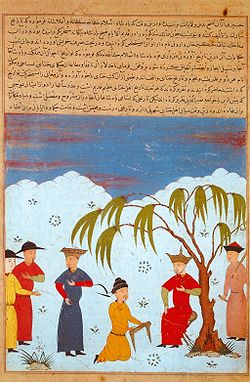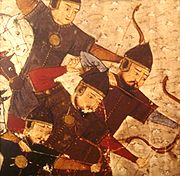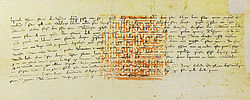
Öljaitü
Encyclopedia

Persian language
Persian is an Iranian language within the Indo-Iranian branch of the Indo-European languages. It is primarily spoken in Iran, Afghanistan, Tajikistan and countries which historically came under Persian influence...
محمد خدابنده - اولجایتو, khodābandeh from Persian meaning the "man of God"; 1280 - December 16, 1316), was the eighth Ilkhanid dynasty
Ilkhanate
The Ilkhanate, also spelled Il-khanate , was a Mongol khanate established in Azerbaijan and Persia in the 13th century, considered a part of the Mongol Empire...
ruler in Iran
Iran
Iran , officially the Islamic Republic of Iran , is a country in Southern and Western Asia. The name "Iran" has been in use natively since the Sassanian era and came into use internationally in 1935, before which the country was known to the Western world as Persia...
from 1304 to 1316. His name "Ölziit" means "blessed" in the Mongolian language
Mongolian language
The Mongolian language is the official language of Mongolia and the best-known member of the Mongolic language family. The number of speakers across all its dialects may be 5.2 million, including the vast majority of the residents of Mongolia and many of the Mongolian residents of the Inner...
.
He was the son of the Ilkhan ruler Arghun
Arghun
Arghun Khan aka Argon was the fourth ruler of the Mongol empire's Ilkhanate, from 1284 to 1291. He was the son of Abaqa Khan, and like his father, was a devout Buddhist...
, brother and successor of Mahmud Ghazan
Mahmud Ghazan
Mahmud Ghazan was the seventh ruler of the Mongol Empire's Ilkhanate division in modern-day Iran from 1295 to 1304. He was the son of Arghun and Quthluq Khatun, continuing a line of rulers who were direct descendants of Genghis Khan...
, and great-grandson of the Ilkhanate founder Hulagu.
Islamic conversion

Christianity
Christianity is a monotheistic religion based on the life and teachings of Jesus as presented in canonical gospels and other New Testament writings...
and received the name Nicholas after Pope Nicholas IV
Pope Nicholas IV
Pope Nicholas IV , born Girolamo Masci, was Pope from February 22, 1288 to April 4, 1292. A Franciscan friar, he had been legate to the Greeks under Pope Gregory X in 1272, succeeded Bonaventure as Minister General of his religious order in 1274, was made Cardinal Priest of Santa Prassede and...
. In his youth he at first converted to Buddhism
Buddhism
Buddhism is a religion and philosophy encompassing a variety of traditions, beliefs and practices, largely based on teachings attributed to Siddhartha Gautama, commonly known as the Buddha . The Buddha lived and taught in the northeastern Indian subcontinent some time between the 6th and 4th...
but then to Sunni Islam
Islam
Islam . The most common are and . : Arabic pronunciation varies regionally. The first vowel ranges from ~~. The second vowel ranges from ~~~...
together with his brother Ghazan. He later converted to Shi'a Islam after coming into contact with Shi'a scholars, although another source indicates he converted to Islam through the persuasions of his wife. He changed his first name to the Islamic name Muhammad. Some of his relatives and companions gave him a nickname of Khutabanda. Rashid al-Din wrote that he adopted the name Oljeitu following Yuan emperor Oljeitu Temur enthroned in Dadu
Khanbaliq
Khanbaliq or Dadu refers to a city which is now Beijing, the current capital of the People's Republic of China...
. But some Muslim source mentions that it rained when he was born, and delighted Mongols called him Mongolian name Öljeitu (Өлзийт), meaning auspicious.
After succeeding his brother, Öljeitu was greatly under the influence of Shi'a theologians Al-Hilli
Al-Hilli
Jamal ad-Din Hasan ibn Yusuf ibn 'Ali ibn Muthahhar al-Hilli , also known as al-Allamah al-Hilli , born December 15, 1250 CE , died December 18, 1325, was a Twelver Shia theologian and mujtahid. Known as a Marja , he was one of the greatest Muslim jurists and scholars of his time...
and Maitham Al Bahrani
Maitham Al Bahrani
Sheikh Maytham bin Ali Al Bahrani was a leading 13th Century Twelver Shi'a Islamic theologian who lived in Bahrain. Al Bahrani wrote on Twelver doctrine, affirmed free will, the infallibility of prophets and imams, the appointed imamate of `Ali, and the occultation of the Twelfth Imam...
. Upon Al-Hilli's death, Oljeitu transferred his teacher's remains from Baghdad
Baghdad
Baghdad is the capital of Iraq, as well as the coterminous Baghdad Governorate. The population of Baghdad in 2011 is approximately 7,216,040...
to a domed shrine he built in Soltaniyeh
Soltaniyeh
Soltaniyeh is a city in and capital of Soltaniyeh District of Abhar County, Zanjan Province, Iran. At the 2006 census, its population was 5,684, in 1,649 families. Soltaniyeh, located some to the north-west of Tehran, used to be the capital of Mongol Ilkhanid rulers of Persia in the 14th century....
. Later, alienated by the factional strife between the Hanafis and the Shafis, Oljeitu changed his sect to Shi'a Islam
Islam
Islam . The most common are and . : Arabic pronunciation varies regionally. The first vowel ranges from ~~. The second vowel ranges from ~~~...
in 1310, believing it to be the true version of Islam.
In 1309, Öljeitu founded a Dar al-Sayyedah ("Sayyed's lodge") in Shiraz
Shiraz, Iran
Shiraz is the sixth most populous city in Iran and is the capital of Fars Province, the city's 2009 population was 1,455,073. Shiraz is located in the southwest of Iran on the Roodkhaneye Khoshk seasonal river...
and endowed it with an income of 10,000 Dinars a year.
He died in Soltaniyeh
Soltaniyeh
Soltaniyeh is a city in and capital of Soltaniyeh District of Abhar County, Zanjan Province, Iran. At the 2006 census, its population was 5,684, in 1,649 families. Soltaniyeh, located some to the north-west of Tehran, used to be the capital of Mongol Ilkhanid rulers of Persia in the 14th century....
, near Qazvin
Qazvin
Qazvin is the largest city and capital of the Province of Qazvin in Iran. At the 2006 census, its population was 349,821, in 96,420 families....
. He was succeeded by his son Abu Sa'id
Abu Sa'id (Ilkhanid dynasty)
Abu Sa'id also Abusaid Bahador Khan, Abu Sayed Behauder , was the ninth ruler of the Ilkhanate state in Iran ....
. Oljeitu's magnificent tomb in Soltaniyeh remains the best known monument of Ilkhanid Persia.
Trade contacts
Trading contacts with European powers were intense during the reign of Öljeitu. The Genoese had first appear in the capital of TabrizTabriz
Tabriz is the fourth largest city and one of the historical capitals of Iran and the capital of East Azerbaijan Province. Situated at an altitude of 1,350 meters at the junction of the Quri River and Aji River, it was the second largest city in Iran until the late 1960s, one of its former...
in 1280, and they had a Consul
Consul
Consul was the highest elected office of the Roman Republic and an appointive office under the Empire. The title was also used in other city states and also revived in modern states, notably in the First French Republic...
in residence by 1304. Oljeitu also gave full trading rights to the Venetians
Venice
Venice is a city in northern Italy which is renowned for the beauty of its setting, its architecture and its artworks. It is the capital of the Veneto region...
through a treaty in 1306 (another such treaty with his son Abu Said was signed in 1320). According to Marco Polo
Marco Polo
Marco Polo was a Venetian merchant traveler from the Venetian Republic whose travels are recorded in Il Milione, a book which did much to introduce Europeans to Central Asia and China. He learned about trading whilst his father and uncle, Niccolò and Maffeo, travelled through Asia and apparently...
, Tabriz was specialized in the production of gold and silk, and Western merchants could purchase precious stones in quantities.
Military alliance




Arghun
Arghun Khan aka Argon was the fourth ruler of the Mongol empire's Ilkhanate, from 1284 to 1291. He was the son of Abaqa Khan, and like his father, was a devout Buddhist...
, Öljeitu continued diplomatic overtures with the West, and re-stated Mongol hopes for an alliance between the Christian nations of Europe and the Mongols against the Mamluks, even though Öljeitu himself had converted to Islam.
1305 embassy
In April 1305, he sent a Mongol embassy led by Buscarello de GhizolfiBuscarello de Ghizolfi
Buscarello de Ghizolfi, or Buscarel of Gisolfe was a European who settled in Persia in the 13th century while it was part of the Mongol Ilkhanate. He was a Mongol ambassador to Europe from 1289 to 1305, serving the Mongol rulers Arghun, Ghazan and then Oljeitu...
to the French king Philip IV of France
Philip IV of France
Philip the Fair was, as Philip IV, King of France from 1285 until his death. He was the husband of Joan I of Navarre, by virtue of which he was, as Philip I, King of Navarre and Count of Champagne from 1284 to 1305.-Youth:A member of the House of Capet, Philip was born at the Palace of...
, Pope Clement V
Pope Clement V
Pope Clement V, born Raymond Bertrand de Got was Pope from 1305 to his death...
, and Edward I of England
Edward I of England
Edward I , also known as Edward Longshanks and the Hammer of the Scots, was King of England from 1272 to 1307. The first son of Henry III, Edward was involved early in the political intrigues of his father's reign, which included an outright rebellion by the English barons...
. The letter to Philip IV, the only one to have survived, describes the virtues of concord between the Mongols and the Franks:
He also explained that internal conflicts between the Mongols were now over:
This message reassured European nations that the Franco-Mongol alliance
Franco-Mongol alliance
Franco-Mongol relations were established in the 13th century, as attempts were made towards forming a Franco-Mongol alliance between the Christian Crusaders and the Mongol Empire against various Muslim empires. Such an alliance would have seemed a logical choice: the Mongols were sympathetic to...
, or at least attempts towards such an alliance, had not ceased, even though the Khans had converted to Islam.
1307 embassy
Another embassy was sent to the West in 1307, led by Tommaso Ugi di SienaTommaso Ugi di Siena
Tommaso Ugi di Siena was a 14th century Italian adventurer, native of the city of Siena in Italy. He resided at the court of the Mongol Ilkhanid ruler Oljeitu in the Persian capital of Tabriz, where he held the high position of Ildüchi, "Sword bearer", for Oljeitu...
, an Italian described as Öljeitu's ildüchi ("Sword-bearer"). This embassy encouraged Pope Clement V to speak in 1307 of the strong possibility that the Mongols could remit the Holy Land
Holy Land
The Holy Land is a term which in Judaism refers to the Kingdom of Israel as defined in the Tanakh. For Jews, the Land's identifiction of being Holy is defined in Judaism by its differentiation from other lands by virtue of the practice of Judaism often possible only in the Land of Israel...
to the Christians, and to declare that the Mongol embassy from Öljeitu "cheered him like spiritual sustenance". Relations were quite warm: in 1307, the Pope named John of Montecorvino
John of Montecorvino
John of Montecorvino or Giovanni da Montecorvino in Italian was an Italian Franciscan missionary, traveler and statesman, founder of the earliest Roman Catholic missions in India and China, and archbishop of Peking, and Latin Patriarch of the Orient.-Biography:John was born at Montecorvino...
the first Archbishop of Khanbalik and Patriarch of the Orient.
European nations accordingly prepared a crusade, but were delayed. A memorandum drafted by the Grand Master of the Knights Hospitallers Guillaume de Villaret
Guillaume de Villaret
Guillaume de Villaret , a native of Languedoc-Roussillon was the 24th Grand Master of the Knights Hospitallers, a position he held from 1296 to his death. He was succeeded by his nephew, Foulques de Villaret, whose career he had done much to advance.-Biography:Before his position as Master, he had...
about military plans for a Crusade envisaged a Mongol invasion of Syria as a preliminary to a Western intervention (1307/8). A corps of Frank mangonel
Mangonel
A mangonel was a type of catapult or siege engine used in the medieval period to throw projectiles at a castle's walls. The exact meaning of the term is debatable, and several possibilities have been suggested. Mangonel may also be indirectly referring to the 'mangon' a French hard stone found in...
specialists is known to have accompanied the Ilkhanid army in the conquest of Herat
Herat
Herāt is the capital of Herat province in Afghanistan. It is the third largest city of Afghanistan, with a population of about 397,456 as of 2006. It is situated in the valley of the Hari River, which flows from the mountains of central Afghanistan to the Karakum Desert in Turkmenistan...
in 1307. Mongols besieged the castle in Gilan so long. Epidimic and lack of food supply forced Gilans to submit to them. He punished Kartids
Kartids
The Kartid Dynasty was a Persian dynasty that ruled over a large part of Khorassan during the 13th and 14th centuries...
in Herat as well.
Military operation of 1308
ByzantineByzantine
Byzantine usually refers to the Roman Empire during the Middle Ages.Byzantine may also refer to:* A citizen of the Byzantine Empire, or native Greek during the Middle Ages...
Emperor Andronicus II gave a daughter in marriage to Oljeitu and asked ilkhan's assistance against growing power of the Ottomans. In 1305, Oljeitu promised his father in law 40,000 men, and in 1308 dispatched 30,000 men to recover many Byzantine towns in Bithynia
Bithynia
Bithynia was an ancient region, kingdom and Roman province in the northwest of Asia Minor, adjoining the Propontis, the Thracian Bosporus and the Euxine .-Description:...
and the Ilkhanid army crushed a detachment of Osman I
Osman I
Osman I or Othman I or El-Gazi Sultan Osman Ghazi, or Osman Bey or I. Osman, Osman Gazi Han), nicknamed "Kara" for his courage, was the leader of the Ottoman Turks, and the founder of the dynasty that established and ruled the Ottoman Empire...
.
1313 embassy
On April 4, 1312, a Crusade was promulgated by Pope Clement VPope Clement V
Pope Clement V, born Raymond Bertrand de Got was Pope from 1305 to his death...
at the Council of Vienne
Council of Vienne
The Council of Vienne was the fifteenth Ecumenical Council of the Roman Catholic Church that met between 1311 and 1312 in Vienne. Its principal act was to withdraw papal support for the Knights Templar on the instigation of Philip IV of France.-Background:...
. Another embassy was sent by Oljeitu to the West and to Edward II
Edward II of England
Edward II , called Edward of Caernarfon, was King of England from 1307 until he was deposed by his wife Isabella in January 1327. He was the sixth Plantagenet king, in a line that began with the reign of Henry II...
in 1313.
That same year, the French king Philippe le Bel "took the cross", making the vow to go on a Crusade in the Levant, thus responding to Clement V's call for a Crusade. He was however warned against leaving by Enguerrand de Marigny
Enguerrand de Marigny
Enguerrand de Marigny was a French chamberlain and minister of Philip IV the Fair.He was born at Lyons-la-Forêt in Normandy, of an old Norman family of the smaller baronage called Le Portier, which took the name of Marigny about 1200....
, and died soon after in a hunting accident.
Öljeitu finally launched a last campaign against the Mamluks (1312–13), in which he was unsuccessful. A final settlement with the Mamluks would only be found when Oljeitu's son signed the Treaty of Aleppo with the Mamluks in 1322.

